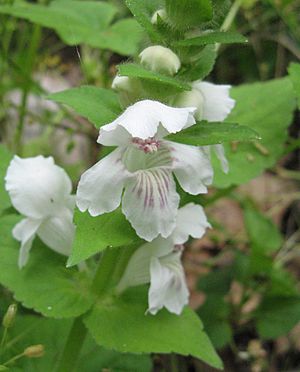Guyandotte beauty facts for kids
Quick facts for kids Guyandotte beauty |
|
|---|---|
 |
|
| Conservation status | |
| Scientific classification | |
| Genus: |
Synandra
|
| Species: |
hispidula
|
| Synonyms | |
|
Lamium hispidulum Michx. |
|
Synandra is a special kind of flowering plant. It belongs to the mint family. This plant group has only one species, called Synandra hispidula. It is also known by its common name, Guyandotte beauty. This plant grows naturally in the east-central United States. You can find it from southern Illinois to western North Carolina and Virginia.
Contents
About the Guyandotte Beauty Plant
What Does the Plant Look Like?
Scientists have studied the Synandra hispidula plant. They found it usually lives for two years. This means it is a "biennial" plant. It has leaves that grow opposite each other on the stem. The edges of these leaves are jagged, like a saw.
The flowers are quite large and pretty. They can be yellow and white, or sometimes pinkish. These flowers bloom from April through June. Each flower can be over 2 centimeters long. Some can even reach 4 centimeters. A single plant can have up to eight branches.
Seeds and How They Grow
The seeds of this plant are called nutlets. They usually weigh about 7 milligrams. Some can weigh up to 13 milligrams. These nutlets store a lot of food inside them. This food helps the new plant grow.
Where the Guyandotte Beauty Lives
Plant Habitat and Environment
This plant likes to grow in shady, wet forest areas. You can often find it near streambanks. It grows well with other plants that like moist forest conditions. These include trees like Acer nigrum (black maple) and Acer saccharum (sugar maple). Other plants found with it are Asimina triloba (pawpaw) and Tilia americana (American basswood). Wildflowers like Jeffersonia diphylla and Caulophyllum thalictroides also grow nearby.
How the Plant Interacts with Nature
The Guyandotte beauty is sensitive to changes in its environment. It does not grow well if the forest trees are cut down. It also struggles if the layer of leaves and twigs on the forest floor is removed.
Deer sometimes eat this plant. When deer graze on it, some plants may die. However, scientists think that the hard seeds might pass through the deer's digestive system. This means deer could help spread the seeds to new places. The flower stalks of the plant are also fragile. They can fall over when the plant is flowering or making seeds. This might also help spread the seeds around.
Protecting the Guyandotte Beauty
Conservation Status
Overall, the Synandra hispidula is considered "secure" as a species. This means it is not in immediate danger of disappearing. However, its numbers have gone down recently. In North Carolina, it is now considered "historic," meaning it is rarely seen there anymore. It is listed as an endangered species in Illinois. It is also "critically imperiled" (very close to extinction) in Alabama. In other states, like Indiana, it is more common. But generally, its growth areas are "scattered."
Threats to the Plant
Many things can harm the Guyandotte beauty. These include:
- Habitat destruction: When its forest home is destroyed.
- Habitat fragmentation: When its home is broken into smaller, separate pieces.
- Logging: Cutting down trees removes the shade it needs.
- Overgrazing: Too many animals eating the plants.
- Trampling: People or animals walking on the plants.
- Recreational activity: Activities like hiking that disturb its habitat.
- Pollution: Harmful substances in the environment.
It is also threatened by introduced species of plants. These are plants that are not native to the area. Examples include Lonicera japonica (Japanese honeysuckle), Dioscorea oppositifolia (Chinese yam), and Microstegium vimineum (Japanese stiltgrass). These plants can take over the space and resources that the Guyandotte beauty needs.
Plant Name Origin
The common name, Guyandotte beauty, comes from the Guyandotte River. This river is located in West Virginia.
See also
 In Spanish: Synandra para niños
In Spanish: Synandra para niños


